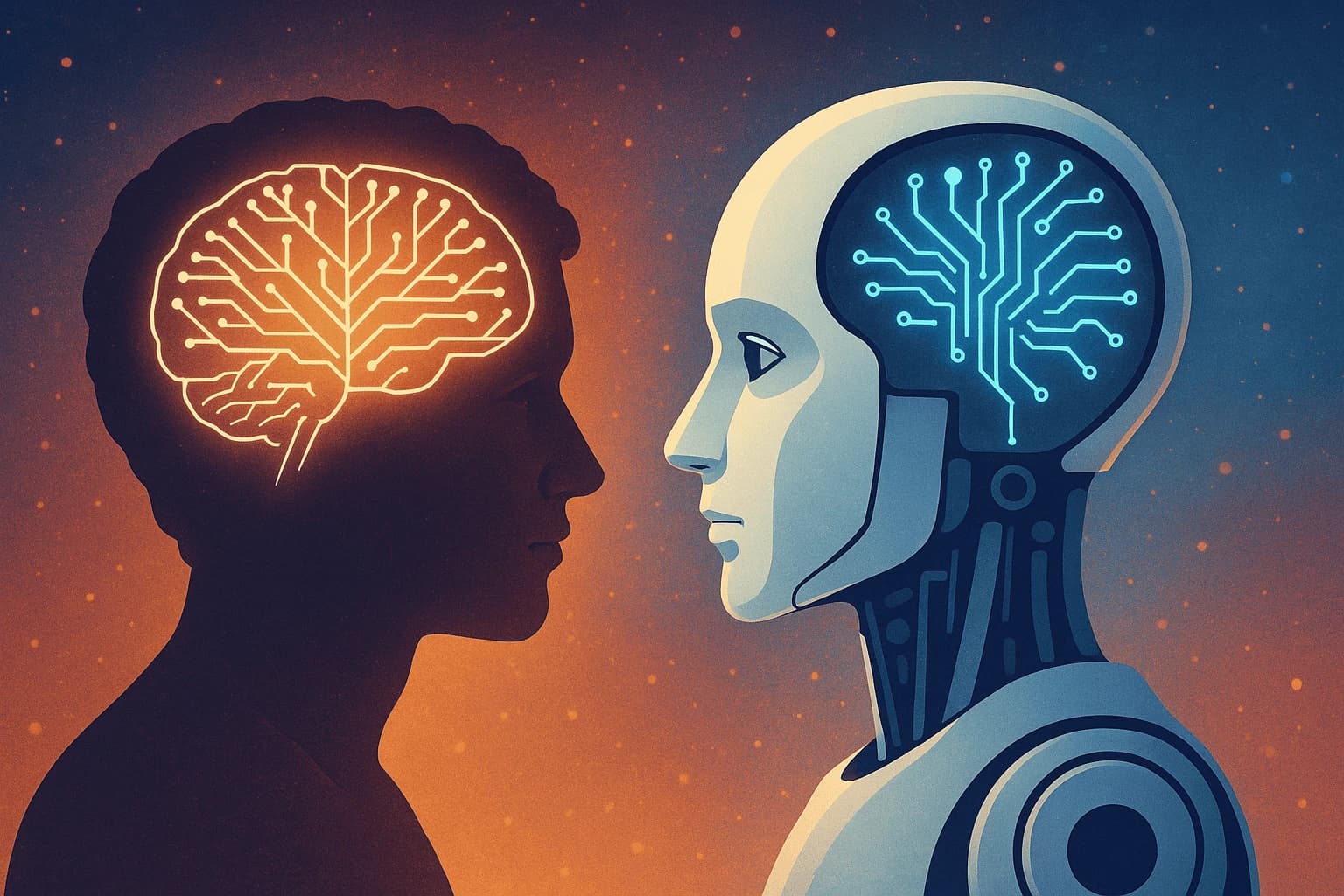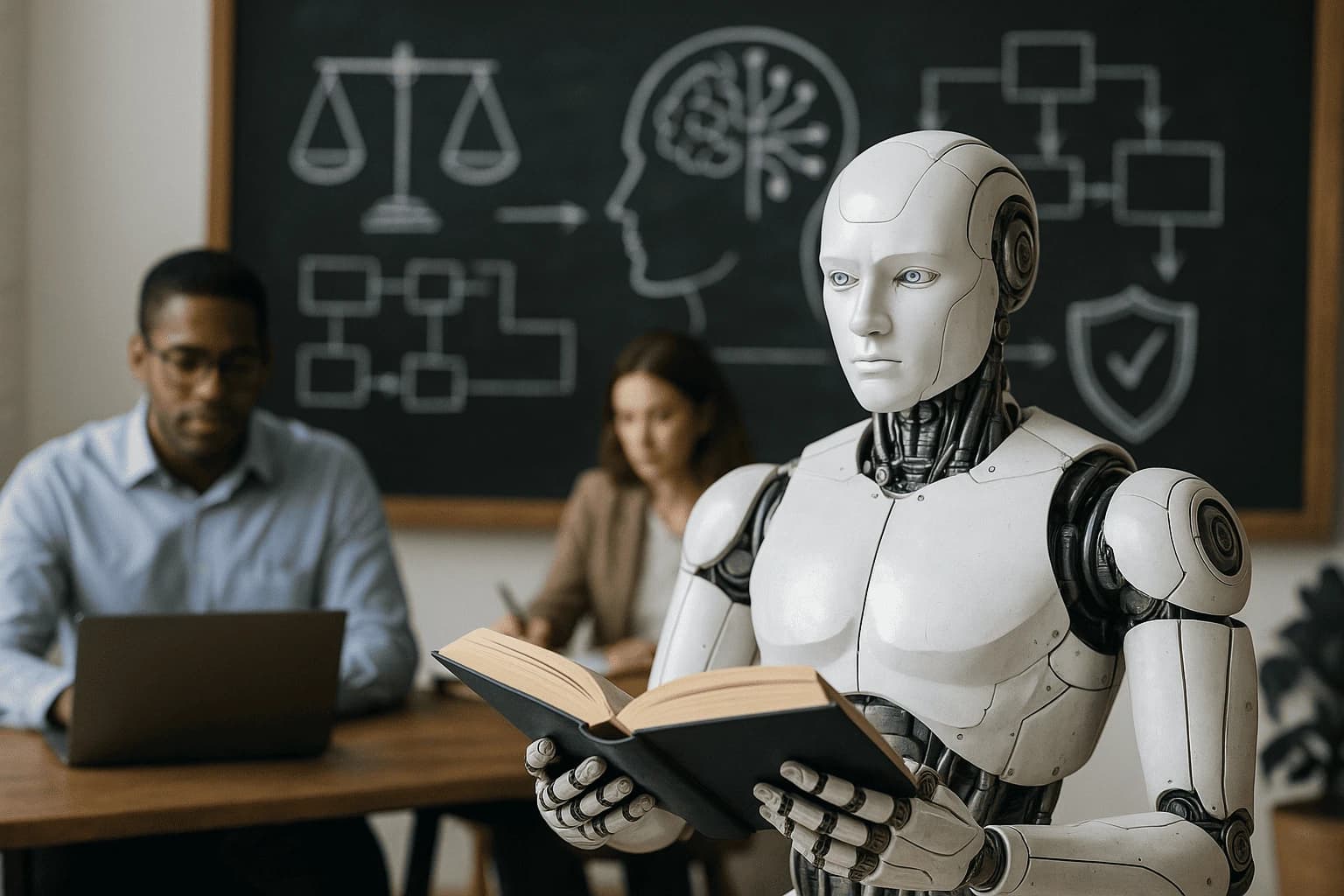
* All product/brand names, logos, and trademarks are property of their respective owners.
In 2025, AI is deeply woven into our daily lives—from drafting emails to diagnosing illnesses. No longer a sci-fi concept, it’s now a powerful tool in decision-making and problem-solving. Yet as machines increasingly mimic human behavior, one critical question remains: how does AI truly compare to human intelligence?
This question is both philosophical and practical. With models like ChatGPT, Gemini, and Claude evolving fast, businesses and educators are rethinking how work is done. AI can write, design, code, and even offer mental health support, processing vast data beyond human capacity—though it still lacks human empathy, nuance, and moral reasoning.
In this article, we’ll explore the cognitive differences between humans and AI, where machines shine, where they struggle, and how this dynamic is reshaping industries and minds. We’ll reference studies like MIT’s 2025 report on AI’s impact on critical thinking and look ahead to developments in agentic AI, AGI, and regulation.
Whether you’re a developer, educator, policymaker, or curious reader, this blog is your guide to understanding the evolving relationship between AI and human intelligence in 2025.
At a glance, artificial intelligence and the human brain might seem similar—they both learn, adapt, and make decisions. But under the hood, their mechanisms couldn’t be more different. The human brain, a product of millions of years of evolution, operates through billions of neurons interconnected in an organic, dynamic network. These neurons fire chemically and electrically to create thought, emotion, memory, and consciousness.
In contrast, AI operates through artificial neural networks, mathematical models inspired loosely by the brain’s structure. These networks are built using layers of artificial neurons (nodes) that process inputs, assign weights, and pass signals forward. While these models can mimic certain types of pattern recognition (like image classification or language translation), they lack consciousness, intention, or self-awareness.
The fundamental distinction? Humans “understand” context and meaning—AI only recognizes patterns. A human can derive intent from sarcasm or tone; AI still often struggles with ambiguity unless explicitly trained on massive, domain-specific data.
Humans learn through experience, emotion, and environment. Learning isn’t just data acquisition; it’s emotional reinforcement, trial and error, and sensory interaction. Even failure becomes a powerful teacher. Human intelligence grows holistically—spiritually, physically, and socially.
AI, on the other hand, learns algorithmically. Through supervised, unsupervised, or reinforcement learning, it processes enormous datasets to identify statistical patterns. It doesn’t "experience" learning—it executes it.
That’s why human adaptability remains superior in unpredictable environments. While AI can be fine-tuned for specific tasks, it often fails when faced with novel problems or ethical dilemmas it hasn’t been trained for.
Even as AI produces stunning art, mimics poetry, and even composes symphonies, most experts agree: it doesn’t truly create—it recombines. Human creativity is born from lived experience, cultural identity, emotion, and subconscious thought. AI lacks this internal wellspring.
Intuition—a powerful, often subconscious synthesis of past experiences and instinct—is another uniquely human strength. While AI might simulate intuition through probabilistic modeling, it cannot “feel” or “sense” in the way humans do.
Emotions, too, remain a human stronghold. From empathy and love to fear and ethical outrage, emotions guide decision-making and social interaction—areas where AI remains logically brilliant but emotionally barren.
In 2025, artificial intelligence has become a powerful force across industries—not because it mimics humanity perfectly, but because it amplifies capabilities where humans face natural limitations. From processing speed to data-driven decision-making, AI shines in environments that demand consistency, precision, and scale.
One of AI’s greatest advantages lies in its ability to process and analyze vast amounts of data at lightning speed. A human doctor might review dozens of cases per week; an AI system can evaluate millions of medical records in minutes. This makes AI ideal for applications in radiology, fraud detection, customer insights, and real-time translation.
Its scalability is unmatched. While human performance may decline with fatigue, AI systems operate 24/7 without breaks, bias (when properly tuned), or emotional distractions. This relentless consistency gives AI the edge in repetitive or high-volume tasks.
AI excels at identifying complex patterns invisible to human cognition. In finance, it detects fraudulent transactions in milliseconds. In cybersecurity, it scans billions of logs to flag anomalies that may signal threats. In marketing, it uncovers user behavior patterns that drive personalized content delivery.
This predictive power is supercharged by machine learning algorithms that continuously improve with feedback loops. In 2025, advanced models are even capable of anticipating market trends, optimizing logistics, and enhancing smart infrastructure with minimal human intervention.
Finance: AI algorithms dominate high-frequency trading, risk modeling, and credit scoring. JPMorgan and other global banks deploy AI for real-time portfolio adjustments.
Medicine: AI-powered diagnostics like PathAI or IBM Watson analyze patient data more accurately than some specialists.
Cybersecurity: AI tools detect ransomware, phishing, and malware before they can breach sensitive systems, often in real time.
These strengths don’t imply superiority overall—but they do underscore where AI’s utility outpaces human ability by design.
While AI thrives in structured, data-rich environments, humans remain unmatched in areas that require emotion, ethical reasoning, and flexible thinking. In 2025, as machines become smarter, the uniquely human traits that AI can't replicate are becoming more valuable—not less.
AI may simulate responses that “feel” empathetic, but it lacks true emotional understanding. Humans bring nuance to ethical dilemmas, informed by culture, experience, and emotion. Whether it’s mediating conflict or navigating moral gray zones, human judgment remains essential.
For instance, an AI might recommend a cost-efficient medical procedure, but only a human can factor in compassion and patient emotion when making the final call.
Humans can adapt instantly to new situations, even when there's no precedent. We intuit context, read between the lines, and modify behavior accordingly. AI still struggles in unstructured, ambiguous environments—especially those requiring social awareness or creative leaps.
Consider leadership, crisis response, or mentorship—roles that demand not just logic but vision, sensitivity, and contextual understanding.
The future isn’t AI versus humans—it’s AI with humans. In 2025, the most successful models combine human judgment with AI’s computational power. Doctors using AI for faster diagnoses, or writers using AI to brainstorm, show how collaboration amplifies both sides.
This synergy—AI for efficiency, humans for wisdom—is key to building responsible, human-centered ai technology ecosystems.
In a world increasingly driven by automation, the qualities that define human intelligence are more important than ever. AI may surpass us in speed and scale, but it still lacks the essence of what makes us truly intelligent.
Humans understand emotion not just as data, but as a lived experience. We empathize, comfort, and decide based on complex ethical considerations shaped by culture, history, and context. AI can simulate caring language, but it doesn't understand pain, fear, or joy. In roles like therapy, education, or justice, empathy and moral judgment remain irreplaceably human.
Humans excel at navigating unfamiliar or chaotic environments. Whether it's a natural disaster, a business pivot, or a cultural shift, we improvise, adjust, and thrive. AI, on the other hand, relies heavily on training data—struggling with scenarios it hasn't seen before. That ability to generalize from sparse experience and apply insight creatively still belongs to us.
In 2025, the smartest organizations aren't choosing between AI and humans—they're combining them. Doctors use AI to analyze scans, but make final decisions based on patient history and emotion. Designers use generative tools for ideas, then refine them with taste and experience.
The key isn’t domination, it’s augmentation—letting AI handle the repetitive and data-heavy, while humans focus on strategy, empathy, and vision.
As AI tools become embedded in daily life—from search engines to decision support—researchers are beginning to ask a critical question: What is all this automation doing to the human brain? In 2025, we're starting to understand the cognitive trade-offs of heavy AI reliance.
A 2025 MIT study made headlines by suggesting that overuse of generative AI—like ChatGPT—can cause users to "offload" thinking. Participants who relied on AI for writing and problem-solving showed reduced activity in regions associated with memory recall and critical reasoning.
This phenomenon, known as cognitive offloading, isn't entirely new. We’ve long outsourced memory to tools like calculators and GPS. But with AI making more complex decisions, we risk losing the deeper skills of synthesis, evaluation, and ethical reflection.
Heavy AI use can lead to reduced engagement in problem-solving. When the machine generates a solution instantly, users may accept it without questioning or exploring alternatives. This weakens our ability to form original thought or challenge assumptions—key traits in learning, innovation, and leadership.
For students, this can mean poorer comprehension. For professionals, it might mean less creativity and weaker judgment. Dependency breeds passivity, and passivity erodes cognition.
Neuroscientists warn that if we consistently let AI "think" for us, our brains will rewire accordingly. Just as taxi drivers develop spatial memory through navigation, frequent AI users may lose cognitive sharpness in areas AI handles.
This doesn’t mean we should avoid AI—but it’s a call to use it wisely, keeping our cognitive muscles active through questioning, collaboration, and reflective thinking.
As AI becomes more powerful and pervasive, the global conversation is shifting from “can we build it?” to “how should we use it?” Between ethical dilemmas, job displacement, and fears of autonomous systems, 2025 marks a turning point in how humanity governs its most advanced technologies.
Artificial General Intelligence (AGI)—a system with human-level reasoning—isn’t here yet, but it’s no longer a distant dream. Leading AI labs like OpenAI, DeepMind, and Anthropic are racing toward agentic systems capable of autonomous action and long-term planning.
This introduces the “control problem”: How do we ensure AI aligns with human goals, values, and safety protocols—even as it grows more powerful than its creators? From alignment theory to AI kill-switches, researchers are urgently exploring fail-safes for future risks.
2025 has seen a wave of global regulation:
Yet, a truly unified global framework remains elusive—raising concerns about regulatory gaps, AI arms races, and uneven ethical standards.
The future isn’t just about keeping AI in check—it’s about empowering people. That means:
By 2030, the societies that thrive will be those that view AI not just as a tool, but as a shared responsibility—one that’s managed with foresight, empathy, and accountability.
In 2025, the line between artificial and human intelligence has never been clearer—or more blurred. On one hand, AI dazzles with its computational might, transforming industries with unmatched speed, accuracy, and efficiency. On the other, it remains fundamentally limited—lacking the empathy, ethics, and intuition that make us human.
This blog has walked through that delicate balance: where AI excels, where humans still lead, and how their coexistence is reshaping everything from work to thought itself. We've seen how cognitive offloading to AI tools may quietly rewire our brains, while global leaders grapple with regulating technologies that evolve faster than laws can follow.
But the most important insight is this: it's not a battle—it's a collaboration. The future belongs not to AI alone or to humans alone, but to those who can merge the two intelligently. In this hybrid age, AI can boost our productivity, but only if we preserve what makes us human—our ethics, creativity, and critical thought.
As we look ahead to 2030 and beyond, the question isn’t just where AI is going. It’s where we are headed with it. And that answer depends on how wisely, ethically, and boldly we shape the partnership.

22 November 2025
No comments yet. Be the first to comment!